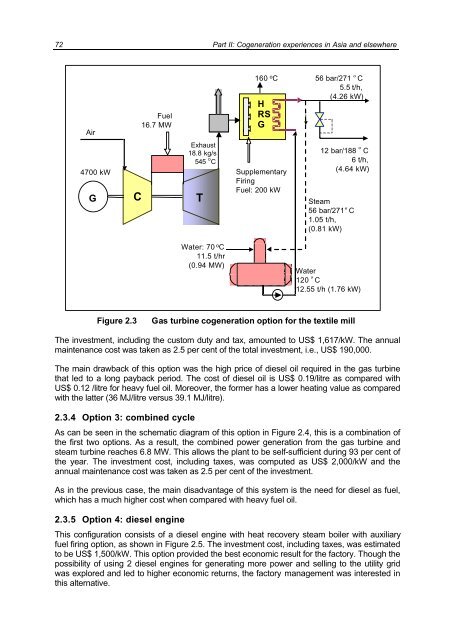part 1: overview of cogeneration and its status in asia - Fire
part 1: overview of cogeneration and its status in asia - Fire
part 1: overview of cogeneration and its status in asia - Fire
Create successful ePaper yourself
Turn your PDF publications into a flip-book with our unique Google optimized e-Paper software.
72 Part II: Cogeneration experiences <strong>in</strong> Asia <strong>and</strong> elsewhere<br />
Air<br />
4700 kW<br />
G<br />
Fuel<br />
16.7 MW<br />
Figure 2.3 Gas turb<strong>in</strong>e <strong>cogeneration</strong> option for the textile mill<br />
The <strong>in</strong>vestment, <strong>in</strong>clud<strong>in</strong>g the custom duty <strong>and</strong> tax, amounted to US$ 1,617/kW. The annual<br />
ma<strong>in</strong>tenance cost was taken as 2.5 per cent <strong>of</strong> the total <strong>in</strong>vestment, i.e., US$ 190,000.<br />
The ma<strong>in</strong> drawback <strong>of</strong> this option was the high price <strong>of</strong> diesel oil required <strong>in</strong> the gas turb<strong>in</strong>e<br />
that led to a long payback period. The cost <strong>of</strong> diesel oil is US$ 0.19/litre as compared with<br />
US$ 0.12 /litre for heavy fuel oil. Moreover, the former has a lower heat<strong>in</strong>g value as compared<br />
with the latter (36 MJ/litre versus 39.1 MJ/litre).<br />
2.3.4 Option 3: comb<strong>in</strong>ed cycle<br />
As can be seen <strong>in</strong> the schematic diagram <strong>of</strong> this option <strong>in</strong> Figure 2.4, this is a comb<strong>in</strong>ation <strong>of</strong><br />
the first two options. As a result, the comb<strong>in</strong>ed power generation from the gas turb<strong>in</strong>e <strong>and</strong><br />
steam turb<strong>in</strong>e reaches 6.8 MW. This allows the plant to be self-sufficient dur<strong>in</strong>g 93 per cent <strong>of</strong><br />
the year. The <strong>in</strong>vestment cost, <strong>in</strong>clud<strong>in</strong>g taxes, was computed as US$ 2,000/kW <strong>and</strong> the<br />
annual ma<strong>in</strong>tenance cost was taken as 2.5 per cent <strong>of</strong> the <strong>in</strong>vestment.<br />
As <strong>in</strong> the previous case, the ma<strong>in</strong> disadvantage <strong>of</strong> this system is the need for diesel as fuel,<br />
which has a much higher cost when compared with heavy fuel oil.<br />
2.3.5 Option 4: diesel eng<strong>in</strong>e<br />
Exhaust<br />
18.8 kg/s<br />
545 o C<br />
C T<br />
Water: 70 o C<br />
11.5 t/hr<br />
(0.94 MW)<br />
160 o C<br />
Supplementary<br />
Fir<strong>in</strong>g<br />
Fuel: 200 kW<br />
56 bar/271 º C<br />
5.5 t/h,<br />
(4.26 kW)<br />
12 bar/188 º C<br />
6 t/h,<br />
(4.64 kW)<br />
Steam<br />
56 bar/271º C<br />
1.05 t/h,<br />
(0.81 kW)<br />
Water<br />
120 º C<br />
12.55 t/h (1.76 kW)<br />
This configuration consists <strong>of</strong> a diesel eng<strong>in</strong>e with heat recovery steam boiler with auxiliary<br />
fuel fir<strong>in</strong>g option, as shown <strong>in</strong> Figure 2.5. The <strong>in</strong>vestment cost, <strong>in</strong>clud<strong>in</strong>g taxes, was estimated<br />
to be US$ 1,500/kW. This option provided the best economic result for the factory. Though the<br />
possibility <strong>of</strong> us<strong>in</strong>g 2 diesel eng<strong>in</strong>es for generat<strong>in</strong>g more power <strong>and</strong> sell<strong>in</strong>g to the utility grid<br />
was explored <strong>and</strong> led to higher economic returns, the factory management was <strong>in</strong>terested <strong>in</strong><br />
this alternative.<br />
H<br />
RS<br />
G









